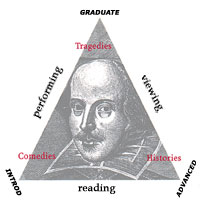Final Essay
by
Marc Couacaud

Very often, we study the written word divorced from its content. We look at works of literature as strange artifacts produced by magic and intelligible only through initiation into an arcane brotherhood of intellectuals. The study of Shakespeare is particularly guilty of this arcane inaccessibility. The great advantage of the sequence of approaches in this course is the movement to even more concrete levels of appreciation of the subject. During this quarter Shakespeare took on new life and meaning for me, so much so, that for the first time I feel that I understand what people are talking about when they speak of Shakespeare's genius. His genius was derived from his complete involvement in, and understanding of, the world around him.
Trendy though it may be, I think that the "new historical" attempt to situate Shakespeare within a dynamic social system of give and take is vital to understanding his work. Shakespeare, more than many others who came before him and after him, used the energy that he found in his society to give life to the words he wrote. The peculiar requirements of producing works of drama for the Elizabethan and Jacobean stages forced him into an intimate association with both the political and religious establishments. His response to their power, his recognition of his own power and that of the theater all intertwine into a complex weave which "is too hard a knot" for us to untie until we begin to examine the diverse historical threads which lead out of the knot in all directions. Greenblatt and the other "New Historicists" have opened the way for scholarly detective work which will expand our thinking and breathe new life into literary studies.
...
The focus of the second third of the course on viewing seems to flow naturally out of the earlier critical approach. Drama, unlike the novel, has a life of its own when it is played upon a stage. .... Because each production is a conscious interpretation of the material, it was easy to see the types of negotiations that were going on between the director's vision of the work and the texts which we had already studied. Different cultures and different purposes transformed parts of the texts while other parts remained constant. In "The Throne of Blood" the themes of Macbeth blend into the structure of traditional Japanese culture slowing down, and even cutting out, some of the action while intensifying Macbeth's internal break. In the Polanski version we see a realism in the portrayal of the witches which forces our attention away from the "fates" and more intensely onto Macbeth.
...
Finally I come to the performance aspect of the course. ...Shakespeare's true artistry slowly became apparent as we tried to figure out ways to "give" the feelings and thoughts life. I never really understood how intricately woven the plays are until we begin to cut lines. One small snip here sent shock waves through the play demanding two or three other alterations. While blocking the movements another important aspect was made very clear as well. Though we had talked earlier about the way Shakespeare embedded his stage directions in the text, to see them unfold from the text as we worked with it was an experience I will never forget. The blocking of the "water to the wisewoman" scene is a point in case. Until we used these words to guide our visual construction, the scene was clumsy. We knew that it should be very funny, but it wasn't until we figured out what to do with our bodies and our props. With the right movements, the tone and quality of the lines also made sense as they hadn't before.
There was, for me, a central thread that linked together the entire fabric of this course. I believe the recognition of "art" as a dynamic system gave a unity to the three approaches which would have been lacking if Shakespeare himself were the only unifying principle. The course moved us toward ever more involvement in the dynamic. The first section got us thinking about it, searching the past for traces of it. The second gave us a visual representation and a three dimensional feeling for what was going on. In the last section we took our places within the dynamic of the play, making meaning for ourselves and holding it up for the audience to see. The audience was also part of the dynamic, giving energy to us and completing the circle.
| TOP |
